A) The bacterium is unable donate DNA through conjugation with another cell.
B) The bacterium cannot take up DNA from its external environment.
C) The bacterium is not able to form an endospore.
D) The bacterium will not reproduce.
F) A) and C)
Correct Answer

verified
Correct Answer
verified
Multiple Choice
Which of the following statements correctly describes both phototrophs and chemotrophs?
A) Both are also autotrophs
B) Both obtain their energy from chemicals
C) Both obtain their energy from light
D) Chemotrophs obtain energy from chemicals and phototrophs obtain energy from light
F) B) and C)
Correct Answer

verified
Correct Answer
verified
Multiple Choice
The following question refers to the figure.
In this eight-year experiment, a population of E. coli, begun from a single cell, was grown in low-glucose conditions for 20,000 generations. Each culture was introduced to fresh growth medium every 24 hours. Occasionally, samples were removed from the population, and its ability to grow in low-glucose conditions was tested against that of members sampled from the ancestral (common ancestor) E. coli population. 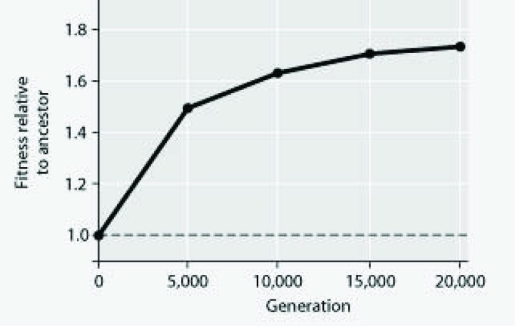 If the experimental population of E. coli lacks an F factor or F plasmid, and if bacteriophages are excluded from the bacterial cultures, how would beneficial mutations be transmitted horizontally to other E. coli cells?
If the experimental population of E. coli lacks an F factor or F plasmid, and if bacteriophages are excluded from the bacterial cultures, how would beneficial mutations be transmitted horizontally to other E. coli cells?
A) sex pili
B) transduction
C) conjugation
D) transformation
F) A) and B)
Correct Answer

verified
Correct Answer
verified
Multiple Choice
While examining a rock surface, you have discovered an interesting new organism. Which of the following criteria will allow you to classify the organism as belonging to Bacteria but not Archaea or Eukarya?
A) Cell walls are made primarily of peptidoglycan.
B) The organism does not have a nucleus.
C) The lipids in its plasma membrane consist of glycerol bonded to straight-chain fatty acids.
D) It can survive at a temperature over 100°C.
F) None of the above
Correct Answer

verified
Correct Answer
verified
Multiple Choice
Recently, a microbe that is able to digest cellulose was discovered in a hot spring with an average temperature of 95°C. This microbe most likely belongs to which of the following groups?
A) Archaea
B) Proteobacteria
C) Cyanobacteria
D) Spirochetes
F) A) and C)
Correct Answer

verified
Correct Answer
verified
Multiple Choice
A bacterium has the following characteristics: ∙ It adheres to the human intestinal lining using a feature that protects it from phagocytes, bacteriophages, and dehydration ∙ It can survive being boiled ∙ It contains no plasmids and relatively little peptidoglycan Which of the following statements best describe the cell wall of this bacterium?
A) Its innermost layer is composed of a phospholipid bilayer.
B) After it has been subjected to Gram staining, the cell should remain purple.
C) It has an outer membrane of lipopolysaccharide.
D) It is mostly composed of a complex, cross-linked polysaccharide.
F) A) and D)
Correct Answer

verified
Correct Answer
verified
Multiple Choice
Which of the following involves metabolic cooperation among prokaryotic cells?
A) binary fission
B) endospore formation
C) biofilms
D) photoautotrophy
F) A) and C)
Correct Answer

verified
Correct Answer
verified
Multiple Choice
The following table depicts characteristics of five prokaryotic species (1-5) . Use the information in the table to answer the question.
 Which two species might be expected to cooperate metabolically, perhaps forming a biofilm wherein one species surrounds cells of the other species?
Which two species might be expected to cooperate metabolically, perhaps forming a biofilm wherein one species surrounds cells of the other species?
A) species 1 and 2
B) species 1 and 3
C) species 2 and 5
D) species 3 and 4
F) A) and B)
Correct Answer

verified
Correct Answer
verified
Multiple Choice
The following table depicts characteristics of five prokaryotic species (1-5) . Use the information in the table to answer the following question.
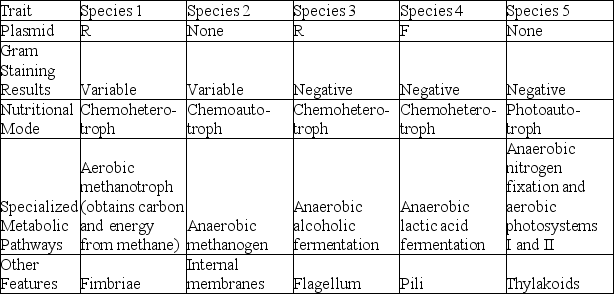 Which of the above species have a cell wall that consists partly of an outer membrane of lipopolysaccharide?
Which of the above species have a cell wall that consists partly of an outer membrane of lipopolysaccharide?
A) species 1 only
B) species 2 only
C) species 3 and 4 only
D) species 3, 4, and 5
F) A) and B)
Correct Answer

verified
Correct Answer
verified
Multiple Choice
The following table depicts characteristics of five prokaryotic species (1-5) . Use the information in the table to answer the question.
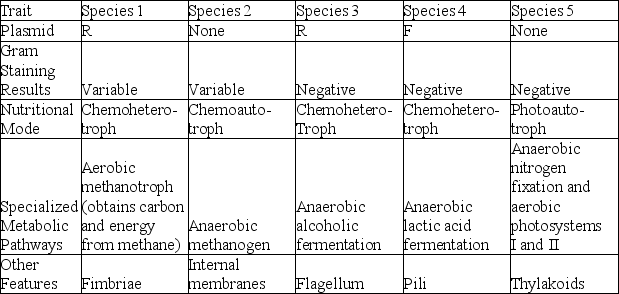 Species 4 is pathogenic if it gains access to the human intestine. Which other species, if it coinhabited a human intestine along with species 4, is most likely to become a recombinant species that is both pathogenic and resistant to some antibiotics?
Species 4 is pathogenic if it gains access to the human intestine. Which other species, if it coinhabited a human intestine along with species 4, is most likely to become a recombinant species that is both pathogenic and resistant to some antibiotics?
A) species 1
B) species 2
C) species 3
D) species 5
F) B) and D)
Correct Answer

verified
Correct Answer
verified
Multiple Choice
Use the following information and graph to answer the question.
The figure depicts changes to the amount of DNA present in a recipient cell that is engaged in conjugation with an Hfr cell. Hfr cell DNA begins entering the recipient cell at time A. Assume that a fragment of the recipient cell's chromosome is exchanged for a homologous fragment from the Hfr cell's DNA. 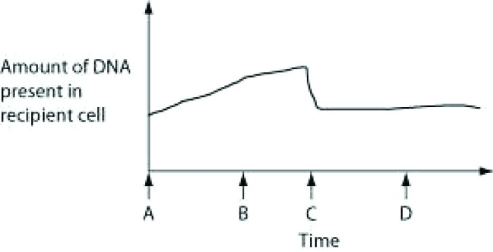 How is the recipient cell different at time D than it was at time A?
How is the recipient cell different at time D than it was at time A?
A) It has a greater number of genes.
B) It has a greater mass of DNA.
C) It contains different genes.
D) It contains bacteriophage DNA.
F) A) and B)
Correct Answer

verified
Correct Answer
verified
Multiple Choice
Use of synthetic fertilizers often leads to the contamination of groundwater with nitrates. Nitrate pollution is also a suspected cause of anoxic "dead zones" in the ocean. Which of the following processes is most likely to help reduce nitrate pollution?
A) adding methanogens to the soil
B) adding nitrifying bacteria to the soil
C) adding denitrifying bacteria to the soil
D) using ammonia instead of nitrate as a fertilizer
F) B) and C)
Correct Answer

verified
Correct Answer
verified
Multiple Choice
Bacteria perform a number of ecological roles. Which role typically involves symbiosis?
A) skin commensalist
B) decomposition
C) chemical recycling
D) immobilizing nutrients
F) None of the above
Correct Answer

verified
Correct Answer
verified
Multiple Choice
A bacterium that lives in the human intestine derives its nutrition by digesting the contents of the intestine. Which mode of nutrition best describes this bacterium?
A) aerobic chemoheterotroph
B) aerobic chemoautotroph
C) anaerobic chemoheterotroph
D) anaerobic chemoautotroph
F) All of the above
Correct Answer

verified
Correct Answer
verified
Multiple Choice
The following table depicts characteristics of five prokaryotic species (1-5) . Use the information in the table to answer the question.
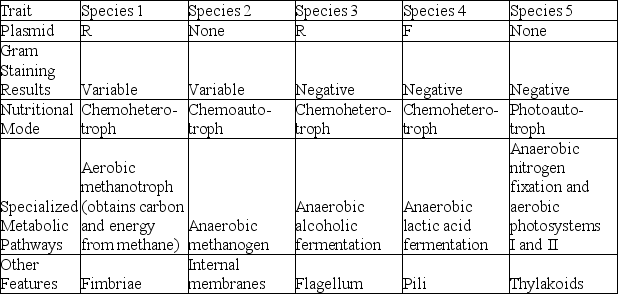 Which species is most likely to be found in sewage treatment plants and in the guts of cattle?
Which species is most likely to be found in sewage treatment plants and in the guts of cattle?
A) species 1
B) species 2
C) species 3
D) species 4
F) A) and C)
Correct Answer

verified
Correct Answer
verified
Multiple Choice
What line of evidence would support a hypothesis that a newly discovered bacterium is a cyanobacterium?
A) It is able to form colonies and produce oxygen.
B) It is an endosymbiont.
C) It forms chains called mycelia.
D) It lacks cell walls.
F) B) and C)
Correct Answer

verified
Correct Answer
verified
Multiple Choice
Which of the following extremophiles is the best model for the earliest organisms on Earth?
A) a prokaryote found near hydrothermal vents
B) an archaean capable of surviving in the polar ice caps
C) an anaerobic archaean species
D) a bacterium that thrives in a highly acidic environment
F) A) and D)
Correct Answer

verified
Correct Answer
verified
Multiple Choice
Assuming that each of these prokaryotes possesses a cell wall, which ones are expected to be most strongly resistant to significant water loss in hypertonic environments?
A) extreme halophiles
B) extreme thermophiles
C) methanogens
D) cyanobacteria
F) None of the above
Correct Answer

verified
Correct Answer
verified
Multiple Choice
Anabaena is a cyanobacterium with two types of cells. One type of cell can carry out photosynthesis and the other type can carry out nitrogen fixation. However, the oxygen produced by photosynthesis inhibits the enzymes for nitrogen fixation. Which structural characteristic allows the nitrogen-fixing cells to continue to function?
A) modified plasma membranes that are impermeable to both oxygen and nitrogen
B) cell walls that are impermeable to both oxygen and nitrogen
C) specialized cells called heterocysts, which have cell walls that restrict the entry of oxygen
D) plasma membranes that are impermeable to nitrogen
F) A) and B)
Correct Answer

verified
Correct Answer
verified
Multiple Choice
What is one of the primary benefits of bioremediation?
A) to improve human health with the help of living organisms such as bacteria
B) to clean up areas polluted with toxic compounds by using bacteria
C) to improve soil quality for plant growth by using bacteria
D) to improve bacteria for production of useful chemicals
F) A) and C)
Correct Answer

verified
Correct Answer
verified
Showing 21 - 40 of 61
Related Exams